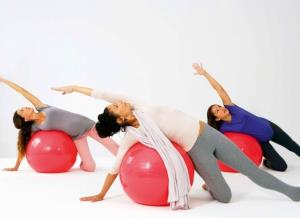
More and more women today are using weights as part of their exercise routines. Weight training is progressive resistance exercises. Free weights (dumbbells and barbells) and exercise machines provide the resistance to the muscles you are working.
The benefits of weight training during pregnancy
A properly planned and balanced weight training programme can meet the goals of prenatal exercise for women who are familiar with this type of training already. Pregnancy is not the time to begin a weight training programme.
Vigour and intensity can be adjusted
One of the biggest advantages of weight training is that its vigour and intensity can be adjusted to the fitness level and trimester of the exerciser.
Feel good and get stronger
Besides getting stronger, you can ward off injuries, build stronger bones, boost your metabolism and feel better about yourself because you look great in the process.
Good for those with varicose veins
Weight training is of real benefit to women who suffer from varicose veins because the movement of the blood through the vessels is enhanced by the squeezing effect of the working muscles.
Great training for labour
As long as the pregnant woman avoids overworking and straining, the consistent strengthening of the body’s muscles, tendons and ligaments will improve joint stability. Improved strength will be beneficial during labour, birth and after you’ve had your baby too.
2 basic principles that apply in weight training
Specificity
Specificity means that you target certain muscle groups in your workout.
For example, a woman may want to improve her upper body strength. A strong upper body helps you maintain good posture, breathe better and lift better.
Overload
Overload requires you to progressively increase the intensity of your workout, over time in a set pattern. You will do this over a period of weeks and months.
If you wish to build strength, rather than just maintain the development you already have, a very gradual increase in the amount of weight being lifted is vital.
Slow, smooth movements are by far, the safest and most beneficial. Your programme should include all the muscle groups – chest, arms, back, thighs and abdomen.
Modification is the key
As your body changes, so should your weight training programme. Switch to lighter weights and lighter repetitions. Extend your rest or recovery periods in between exercises. Listen to your body. You are weight training not to re-sculpt your body but to tone and strengthen it.
Using free weights
The use of free weights in pregnancy remains a controversial issue. The dangers lie in straining the abdomen, damaging connective tissue or dropping a weight on the abdomen. If you are a regular trainer you can continue, but with caution.
Remember though, that a woman using free weights should never exercise alone. If you suffer from high blood pressure, threathened miscarriage, premature labour or sore unstable joints, don’t do weight training. You can still use your gym membership to full advantage though...
Gym classes that are safe during pregnancy
Aerobic classes
Low impact, gentle aerobic movement is safe for pregnancy if done with careful adaptations. Move at a steady pace and keep your pulse rate between 120 to 140.
Ball classes
The Fitball is especially great for pregnant exercisers. There are many positions and movements that you can do on the ball that you can’t do on anything else.
Be sure to get used to sitting on the ball before becoming too adventurous. The ball is excellent for balance and safe abdominal work.
Cycling (stationary)
Women who enjoy outdoor cycling may be encouraged to continue this form of exercise until they feel that they are no longer comfortable or that their centre of balance has shifted.
You may find that the curved body position puts too much pressure on the uterus or the lower back. As an alternative, switch to stationary cycling.
Dance exercise classes
A woman who has enjoyed dance exercise classes may continue to do so during pregnancy. If any of the movements cause pain in the joints, modify them so that you feel no discomfort. If a particular movement continues to cause pain, leave it out.
Exercises that need you to lie flat on your belly, to arch your back, to jump, leap or tumble must be avoided.
Karate
You don’t have to abandon your training as long as you are careful and work together with the instructor or teacher to avoid injury. Listen to your body and avoid sparring and manoeuvers that may hurt the joints, especially after the first trimester.
Stretch and tone classes
Stretch and tone classes can be continued throughout pregnancy. You can make adaptations if any exercise or position hurts. Stretches should never be taken to the maximum point of resistance.
Power-pump classes
Power-pump classes are great for building strength and stamina.
During the first half of pregnancy, you should work at a lesser pace with lighter weights and be sure of your steps if you are using a step-up bench.
If attending “step” classes, the step or bench should be at their lowest level. As your centre of gravity and balance changes, it may become more difficult to perform exercises and movements that were easy before.
Kata-box or kick-boxing also requires tremendous abdominal strength and balance and some of the movements are contraindicated during pregnancy.
Swimming
Swimming is, in many ways, an ideal way to exercise. Treading water is also excellent and provides you with a total body workout. It is an excellent way to train for the breathing of labour.
Extended breath holding is not advised, as this could compromise oxygen supply to the baby. Do not swim until you are breathless or exhausted.
If you feel abdominal pulling, you should avoid the back crawl stroke. If your back hurts, try the sidestroke, as this is a favorite of many. If you are not up to swimming, walk across the pool instead.
Treadmill
You can continue to use a motorised treadmill but should monitor your pulse rate, note any discomfort and change the use accordingly. A walking workout or moderate jogging pace can be set up on an individual basis. Keep to 15-minute sets.
Yoga
With its gentle stretching and concentrated breathing, yoga is perfect to prepare for labour and birth. It relieves tension, tones muscles and enhances flexibility.
Avoid strenuous upwards or backwards stretches or any bending seated positions that put pressure on the uterus. Yoga that includes vigorous abdominal contractions should definitely be avoided.
Important things to remember
A pregnant woman should never exercise alone and always check with your doctor or caregiver before starting any form of exercise. Remember that a great body is not as important as a healthy baby
Experts agree that a 140 beats per minute heart rate is a safe guideline for exercise and high enough to keep you fit. Breathing awareness, constant self-monitoring and keeping well hydrated is important.




 Publications
Publications
 Partners
Partners










